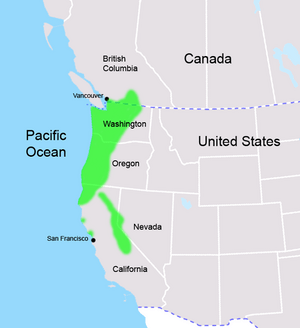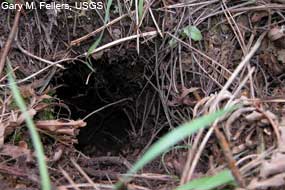Mountain beaver facts for kids
Quick facts for kids Mountain beaver |
|
|---|---|
 |
|
| Conservation status | |
| Scientific classification | |
 |
The mountain beaver (Aplodontia rufa) is a small rodent that lives in North America. It's the only living member of its group, called Aplodontia, and its family, Aplodontiidae. Even though it's called a "beaver," it's not closely related to the true North American or Eurasian beavers. Instead, it's more like a squirrel.
There are seven different types, or subspecies, of mountain beavers. Six of these are found in California, and three of them live only in that state.
Contents
What Makes Mountain Beavers Special?

Scientists sometimes call the mountain beaver a "living fossil." This is because it has some very old features, especially in its skull and jaw muscles. These features are similar to what was found in some of the earliest mammals.
The mountain beaver is the only living rodent that still has these primitive features. This makes it a unique animal to study!
Family Tree
Studies show that the mountain beaver is closely related to squirrels. Scientists group them together in a larger family tree.
Fossils tell us that the mountain beaver's family split off from squirrels a long, long time ago, during a period called the Middle or Late Eocene. However, fossils of the Aplodontia group itself have only been found from the Late Pleistocene in North America.
Types of Mountain Beavers
There are seven recognized types of mountain beavers, each living in a specific area:
- A. r. californica: Found in the Sierra Nevada mountains in Northern California and western Nevada.
- A. r. humboldtiana: Lives only on the far northwestern coast of California.
- A. r. nigra: Found in a small area in southern Mendocino County, California.
- A. r. pacifica: Lives along the coast of Oregon.
- A. r. phaea: Mostly found in Point Reyes, northwest of San Francisco, California.
- A. r. rainieri: Lives across the Cascade Range from southern British Columbia to southern Washington.
- A. r. rufa: Found along the coast of Washington, through Oregon, and into Northern California.
Appearance and Features
Mountain beavers are usually dark gray or brown. Their fur can be a bit reddish or blackish, depending on the specific type. They have a light patch of fur under each ear.
These animals have very short tails, which is a key difference from true beavers. Adults typically weigh between 500 and 900 grams (about 1 to 2 pounds). They are about 30 to 50 centimeters (12 to 20 inches) long, with a tiny tail only 1 to 4 centimeters (0.4 to 1.6 inches) long.
Not Like True Beavers
Even though they share a name, mountain beavers are quite different from true beavers. They are similar only in their size, strong smell, love for wet places, and habit of chewing bark and cutting branches.
However, mountain beavers do not:
- Cut down large trees.
- Build dams.
- Live in lodges (their homes).
- Communicate by slapping their tails (their tail is too small).
They are mostly active at night and during twilight hours. They can climb trees a few meters high to find food like branches and leaves.
Unique Teeth
Mountain beavers have a special bump on each of their molar and premolar teeth. This bump is unique among mammals and helps identify their teeth easily. Their cheek teeth are simple and grow continuously throughout their lives.
Water Needs
Mountain beavers cannot make very concentrated urine. This means they need to drink a lot of water every day. Because of this, they mostly live in wet areas like temperate rain forests along the Pacific coast of North America. They prefer plants that have a lot of water in them.
Where They Live
Mountain beavers are found in the Cascade Mountains of British Columbia and south through the Cascade Range in the United States. They also live in the Olympic Mountains, Coast Ranges of Washington and Oregon, Klamath Mountains, and the Sierra Nevada and Pt. Reyes areas of California, and extreme western Nevada.
They can live from sea level all the way up to the tree line in mountains. They are found in both forests with leafy trees and forests with pine trees. However, they seem to prefer leafy forests in most parts of their range.
Behavior
Mountain beavers can climb trees, but they usually stay close to their burrows. They have slightly opposable thumbs, which means they can sit on their back legs and use their front paws to hold and eat food.
These animals are not social and usually live alone in their burrows. Their burrows are networks of tunnels built deep in the soil. The entrances often have piles of wilted plants, which they might use for food or nesting material.
Mountain beavers rarely go far from their burrow entrances. The burrows protect them from predators like cougars and owls. They also build piles of hay at some burrow entrances, but scientists are still debating why they do this.
They are active both day and night, but more so at night. They feed for several short periods throughout the day, adding up to about 9 hours of foraging daily. They don't hibernate and don't conserve body heat as well as other rodents. This is another reason they need to live in moist, cool places.
Diet
Mountain beavers are herbivorous, meaning they only eat plants. They eat soft plant material and young shoots from woody plants. Ferns are a big part of their diet. They even eat their own soft waste to get all the nutrients!
Sometimes, they eat young tree seedlings, which can cause problems for forests.
Predators and Problems
Animals that hunt mountain beavers include bobcats, coyotes, weasels, cougars, golden eagles, and owls.
One interesting fact is that the mountain beaver is home to the largest known flea, called Hystrichopsylla schefferi. Female fleas of this type can be up to 8 millimeters (about 0.3 inches) long!
Mountain beavers can be considered pests in some areas because they damage forest trees. They chew bark, cut branches, and clip small trees. This can harm young trees, slow their growth, or even kill them. Because of this, the United States Forest Service has programs to control mountain beaver populations. Methods include trapping, using special baits, and putting plastic barriers around tree bases.
Reproduction and Life Cycle
Mountain beavers breed between January and March. Two or three young are born from February to April. The babies are born without hair, pink, and blind. They drink their mother's milk for 6 to 8 weeks and then leave the burrow.
Mountain beavers can live for 5 to 10 years, which is quite long for a rodent! They are usually solitary, but if there's a good spot with lots of food, several might live in the same area.
Status and Protection
The IUCN (International Union for Conservation of Nature) lists the mountain beaver as a species of "least concern." This means it's not currently at high risk of disappearing.
However, one specific type, the Point Arena mountain beaver (A. r. nigra) in California, is considered endangered by the U.S. Fish and Wildlife Service. It's also listed as "Critically Imperiled" by NatureServe. This subspecies is known for its black fur and smaller size. The main threat to it is that its habitat is being lost and broken up into smaller pieces. Its remaining home is a small area of about 24 square miles in western Mendocino County.
Images for kids
See also
 In Spanish: Castor de montaña para niños
In Spanish: Castor de montaña para niños





